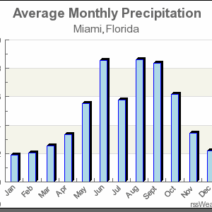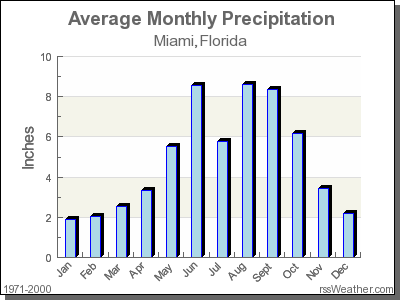Miami, Florida, often dubbed “The Magic City,” is renowned for its vibrant culture, stunning beaches, and incessant sunshine. However, the climate here is a significant factor that contributes to its allure. Understanding this tropical paradise’s climate reveals an intricate tapestry of meteorological aspects that together create a unique environment, appealing to millions of visitors and residents alike. This exploration delves into Miami’s climatic characteristics, seasonal variations, and the underlying reasons for its captivating weather conditions.
First and foremost, Miami operates under a tropical monsoon climate, classified as Aw according to the Köppen climate classification. This unique classification signifies a tropical environment with a distinct wet and dry season. A characteristic feature of this climate is the warm temperatures throughout the year, without significant seasonal variations. Even during winter, Miami remains a warm haven, providing an attractive escape from the frigid climes found elsewhere in the United States.
The summers in Miami are particularly noteworthy. They are synonymous with consistent heat and humidity, creating what many describe as a “sultry” atmosphere. As the calendar flips to June, the temperatures begin to rise, peaking in July and August. During these months, average high temperatures soar to around 88°F (31°C). Yet, the relentless humidity can push the heat index to feel like well over 100°F, making outdoor activities feel more laborious.
But Miami’s summer heat is not simply a matter of sweltering temperatures; it is the combination of heat and humidity that evokes a sense of relentless warmth, causing visitors and locals alike to seek refuge in air-conditioned spaces or near cooling waters. The humidity level frequently exceeds 70%, while in the afternoons, it can be close to 80%. This persistent moisture is a defining aspect of Miami’s summer climate.
The elevated humidity levels play a critical role in the city’s precipitation patterns. While summer is characterized by hot days, it also heralds the onset of the rainy season, typically beginning in May and culminating in October. On average, June through September experiences almost daily thunderstorms, often occurring in the late afternoon or evening. These thunderstorms are typically short-lived yet can result in torrential rains, creating localized flooding.
Despite the frequent rain, these storms contribute to the region’s lush vegetation. Miami’s natural environment flourishes with palatial palm trees, resilient mangroves, and vibrant flora that requires the copious rainfall to thrive. This abundant greenery not only enhances the city’s aesthetic charm but also plays a pivotal role in local biodiversity and ecology.
On the other hand, Miami’s winter months, stretching from December to February, provide a stark contrast to its scorching summers. Temperatures plummet, albeit modestly, with average highs ranging from 70°F (21°C) to 75°F (24°C). The mild temperatures attract tourists seeking refuge from colder northern regions, establishing Miami as a winter haven. The lack of snow and frost creates an inviting atmosphere for a variety of outdoor activities and events throughout this season.
In addition to temperature fluctuations, Miami’s geography significantly influences its climate. Nestled between the Atlantic Ocean and the Everglades, Miami’s coastal position moderates temperatures and contributes to its humidity levels. The ocean breezes act as a natural air conditioner, providing a degree of relief from the heat, particularly in the less intense winter months. However, this proximity to large bodies of water also heightens the risk of severe weather phenomena, including hurricanes.
Hurricane season runs from June 1 to November 30, with peak activity typically observed from August to October. During these months, the risks of tropical storms and hurricanes loom large, casting a shadow over the city’s otherwise inviting climate. Preparedness and awareness become integral to life in Miami, as residents must be attuned to weather forecasts and potential threats posed by the tumultuous Atlantic waters. This aspect of climate life in Miami demands vigilance and resilience from its community.
Climate change also looms as a significant concern for Miami. Rising global temperatures are leading to increased sea levels, posing a dire threat to coastal cities. Miami is particularly vulnerable to flooding caused by higher tides and intense rainfall events. The city has initiated various projects aimed at resilience, such as coastal restoration efforts and improved drainage systems. However, the long-term threat remains a pressing issue that necessitates ongoing attention from both policymakers and residents.
The fascination with Miami’s climate transcends mere numbers and weather patterns. It embodies a lifestyle marked by outdoor living, beach activities, and cultural vibrancy. The warm climate promotes a sense of relaxation and enjoyment of life. Miamians embrace their environment, with activities such as yoga on the beach, outdoor festivals, and a plethora of water sports. The intertwining of climate and culture creates a unique allure, drawing people to experience the city’s offerings firsthand.
In conclusion, the climate in Miami, Florida, encapsulated by consistent warmth, humidity, and vibrant weather patterns, contributes significantly to its status as a beloved destination. Each season brings its own charm, with summer’s relentless warmth and winter’s mild respite capturing the hearts of many. However, this climatic beauty is juxtaposed with the realities of climate change and the implications it holds for urban living. Miami’s climate is not merely a backdrop; it is an integral part of what makes this city a fascinating, living entity. As climate challenges mount, the response and adaptation of communities will determine the future of this tropical haven.





